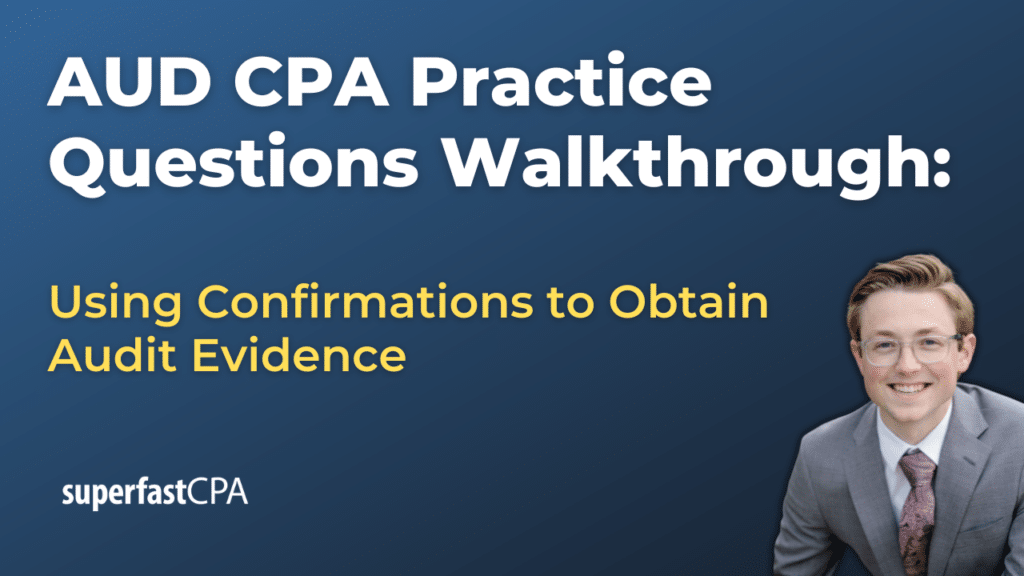In this video, we walk through 5 AUD practice questions teaching about using confirmations to obtain audit evidence. These questions are from AUD content area 3 on the AICPA CPA exam blueprints: Performing Further Procedures and Obtaining Evidence
The best way to use this video is to pause each time we get to a new question in the video, and then make your own attempt at the question before watching us go through it.
Also be sure to watch one of our free webinars on the 6 “key ingredients” to an extremely effective & efficient CPA study process here…
Using Confirmations to Obtain Audit Evidence
Audit confirmations are a vital tool for obtaining relevant and reliable evidence. As part of an external audit, auditors use confirmation techniques to independently verify information related to significant account balances and transactions. This guide outlines the various types of confirmations, the auditor’s responsibilities, how to handle non-responses, evaluate exceptions, and interpret responses that contain disclaimers.
Types of Audit Confirmations
There are several types of audit confirmations, each used based on the level of audit risk and the nature of the account being tested:
- Positive Confirmations: These require a response from the recipient regardless of agreement or disagreement with the stated amount. For example, an auditor may confirm with a customer, “Do you agree that you owe our client $8,740 as of December 31?” A response is expected either way.
- Negative Confirmations: These request a response only if the recipient disagrees with the stated amount. For instance, a confirmation might state, “If you disagree with the $115 balance, please notify us.” If there is no response, the auditor assumes agreement.
- Blank Confirmations: A subtype of positive confirmation in which the recipient is asked to fill in the balance themselves. While this approach offers higher assurance, it may result in a lower response rate due to the additional effort required by the respondent.
Auditor’s Responsibilities in the Confirmation Process
Auditors must maintain full control over the confirmation process to preserve the integrity of the evidence. The responsibilities include:
- Selecting the items or accounts to confirm.
- Determining the appropriate confirmation method.
- Designing the confirmation requests.
- Sending the requests directly to the third party.
- Receiving responses directly without client involvement.
The client may assist in providing contact information, but under no circumstances should the client handle the sending or receiving of confirmations.
Handling Non-Responses to Confirmations
When confirmation responses are not received, the auditor should not immediately assume an issue. The appropriate actions include:
- Sending one or more follow-up requests.
- Performing alternative audit procedures such as examining subsequent cash receipts or related shipping documentation.
- If those efforts fail, the auditor may request that the client contact the customer to encourage a response. However, the response must still be returned directly to the auditor.
For example, if a customer fails to respond after two attempts, and no supporting documentation exists for the receivable balance, the auditor may ask the client to reach out to the customer to understand the lack of response.
Evaluating Confirmation Exceptions
An exception arises when the information in a confirmation response differs from the client’s records. These discrepancies can indicate:
- Errors in transaction recording.
- Timing differences, such as cutoff issues.
- Unrecorded discounts or returns.
- Deficiencies in internal controls.
For instance, if a customer states a balance of $2,300 while the client records $3,000, the auditor must investigate the $700 difference to determine its cause and assess its implications.
Interpreting Disclaimers in Confirmation Responses
Sometimes, confirmation responses contain standard legal disclaimers such as “This response is for informational purposes only and does not constitute confirmation of liability.” These generic disclaimers typically do not reduce the reliability of the evidence, provided that:
- The information is complete and consistent with audit objectives.
- The response is received directly from a competent and independent third party.
The auditor should focus on the substance of the response rather than the standard language used.
Conclusion
Audit confirmations are a powerful method for obtaining third-party evidence related to account balances and transactions. Effective use of confirmations requires understanding the appropriate types to use, ensuring auditor control over the process, following up on non-responses with appropriate actions, evaluating any discrepancies thoroughly, and recognizing when disclaimers do not compromise evidence quality. Mastery of these practices is essential for successfully performing audit engagements and preparing for the CPA Exam.














